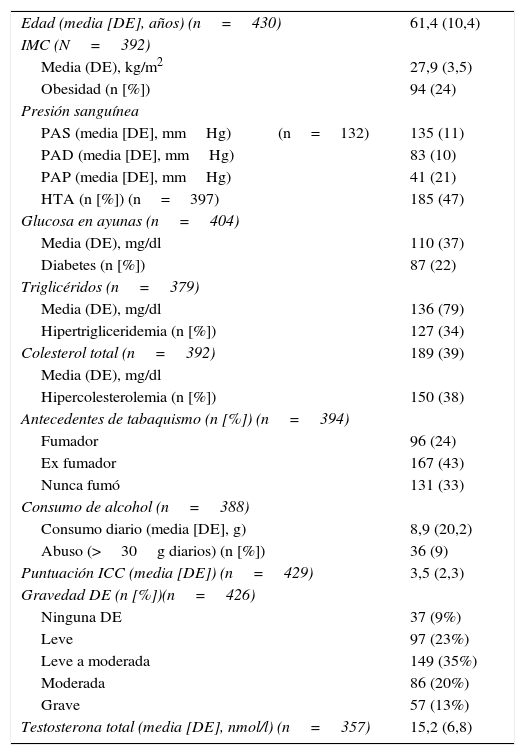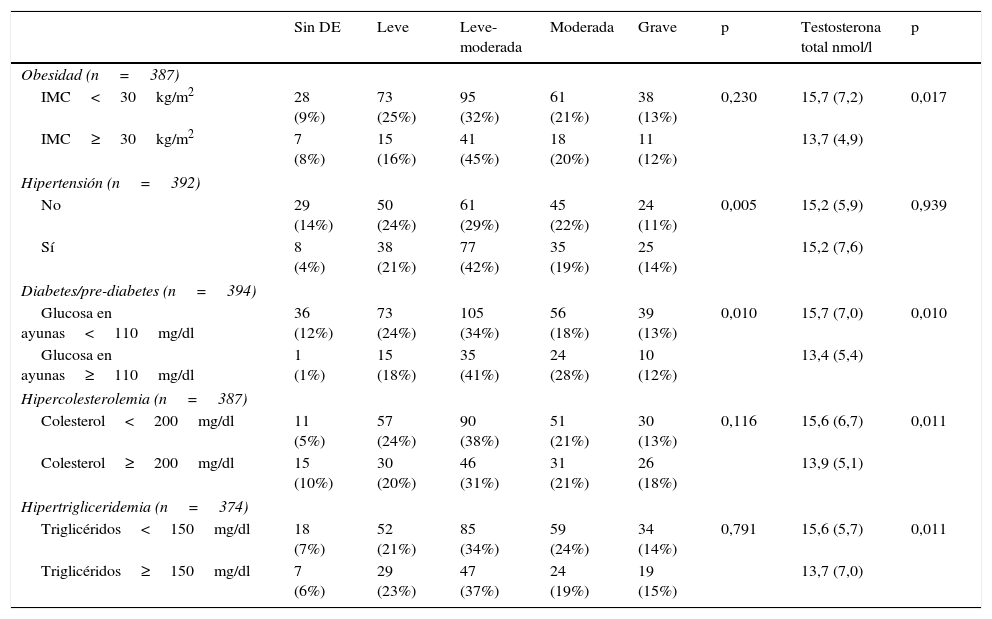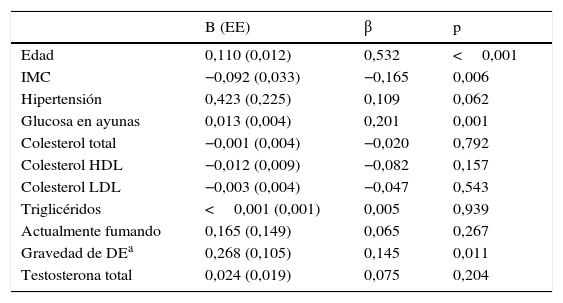Explorar la relación entre la disfunción eréctil (DE), los niveles de testosterona y el Índice de comorbilidad de Charlson (ICC).
Material y métodosEstudio transversal en pacientes derivados a la unidad de andrología de 7 hospitales españoles. La DE se diagnosticó y clasificó mediante el International Index of Erectile Function. Los niveles de testosterona, la prevalencia de cada comorbilidad y el ICC se compararon entre pacientes con distintos grados de DE. Además de la correlación entre la testosterona total y el ICC, la influencia de cada comorbilidad y de la severidad de la DE en el ICC se evaluaron mediante una regresión lineal múltiple.
ResultadosEl estudio incluyó 430 hombres con una media de 61 años de edad. El ICC medio fue 3,5 y la testosterona total 15,2nmol/l; 389 (91%) de los sujetos tenían algún grado de DE: 97 (23%) leve, 149 (35%) leve a moderada, 86 (20%) moderada y 57 (13%) severa. La severidad de la DE se asoció a un nivel menor de testosterona (p=0,002) y a un mayor ICC (p<0,001). Los niveles de testosterona fueron significativamente menores en pacientes con obesidad, diabetes, hipercolesterolemia e hipertrigliceridemia (p<0,05). Sin embargo, únicamente la diabetes y la hipertensión mostraron una relación significativa con la DE. El modelo multivariado, que incluía variables relacionadas con todas las comorbilidades evaluadas, los niveles de testosterona y la severidad de la DE, predijo el ICC (p<0,001, R2=0,426). La severidad de la DE mostró una contribución significativa al modelo (p=0,011), pero la testosterona total no (p=0,204).
ConclusionesEl ICC se asocia significativamente con la severidad de la DE, pero muestra una correlación débil con los niveles de testosterona.
To explore the potential relationship between erectile dysfunction (ED), low testosterone levels, and the Charlson Comorbidity Index (CCI).
Material and methodsCross-sectional study on patients referred to the andrology unit in 7 Spanish centers. The ED was diagnosed and graded using the International Index of Erectile Function (IIEF-5) score. Total testosterone, the prevalence of each comorbidity, and the CCI were compared between patients with different grades of ED. Besides, the correlation between total testosterone and the CCI score, the influence of each comorbidity, and the ED severity on the CCI was assessed in a multiple linear regression.
ResultsThe study included 430 men with a mean age of 61 years. The mean CCI was 3.5, and mean total testosterone 15.2 nmol/L; 389 (91%) subjects had some grade of ED: 97 (23%) mild, 149 (35%) mild-to-moderate, 86 (20%) moderate, and 57 (13%) severe. The increase in ED severity was significantly associated with a decrease in total testosterone (P=.002), and an increase in the CCI score (P<.001). Testosterone levels were significantly lower in patients with obesity, diabetes, hypercholesterolemia, and hypertriglyceridemia (P<.05). However, only the prevalence of diabetes and hypertension was significantly associated with the severity of ED. The multivariate analysis including variables related to all assessed comorbidities, total testosterone levels, and the DE severity significantly predicted the CCI score (P<.001, R2=.426). The severity of ED significantly contributed to this model (P=.011), but total testosterone did not (P=.204).
ConclusionsThe CCI is significantly associated with the ED severity, but it shows a weak correlation with the testosterone levels.
Artículo
Comprando el artículo el PDF del mismo podrá ser descargado
Precio 19,34 €
Comprar ahora












